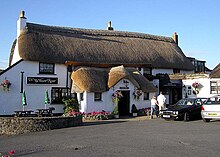I've discussed before how monasticism began in the third century, when Saint Anthony decided to become a hermit and headed out into the desert of Egypt. Monasticism, that is leading a life separated from society, devoted to prayer and contemplation, quickly developed two main versions: eremetism, that is being a hermit by yourself, and cenobitism, living in well-disciplined groups.
Saint Anthony was soon joined in the desert by other men, and even a few women, trying to lead a holy life of prayer and privation. Egypt was a good place to do this, because once you get away from the Nile you're out in the desert and could be miles from anywhere, even though you're only a few hours' walk from town. And this is important, because if someone is living alone and praying all day, he needs people to bring him food and (if he didn't have the sense to set up by a desert spring) water.
Soon there were a lot of desert fathers, mostly leading solitary lives, though an oasis might support a group. They were greatly admired for their holiness, their radically simple lives, and indeed became tourist attractions. Accounts of their lives, their holiness, and their miracles were written up. People would come and visit them and ask for their wisdom. Some of the hermits hid in their cells and wouldn't answer the door when pilgrims came by. Others welcomed pilgrims and sold them sandals or prayer mats woven from palm fronds.
By the fourth and fifth centuries, regular tours of the Egyptian desert fathers were organized out of Jerusalem. Jerusalem, like the rest of the Roman Empire, was thoroughly Christian at this time. One surviving traveler's account recounts all the different hermits they visited, the sayings and wisdom of each, and the travelers' various adventures, like being chased for miles by a hippopotamus.
Long after Egypt, along with the Middle East and the rest of north Africa, had become majority-Muslim regions, Christians remembered the desert fathers and read their stories. Monasteries in western Europe liked to say they were founded "in the desert," meaning not a sandy place but somewhere desolate, wild, deserted by anyone before they showed up.
One particular monastery, Saint Martin's of Tournai (northern end of the French kingdom), had an especial attraction to the desert fathers. It was an old monastery that had become abandoned during the time of the Vikings. In the eleventh century, it became simply a parish church in town, served by a small group of canons (priests). In the twelfth century, the priests read their Bibles and heard about monasteries being founded and decided to become monks, living a much more austere life than did priests: a strictly vegetarian diet, simplicity in clothing, no personal possessions.
As a parish church, Saint Martin's had been very much part of the community, with people popping into the church to pray or ask for blessing or attend mass or to have a child baptized or a wedding performed or just to chat with the priests. All this continued after the priests became monks. As monks, they started to feel that maybe they had not sufficiently distanced themselves from society, especially as people were always talking and laughing and going about their business right outside the church. But they loved their community and didn't want to drive them away. Some community members had themselves decided to become monks, bringing a few children with them.
Reading the stories of the desert fathers, the monks had a brilliant idea. They would head off to Egypt and become desert fathers themselves! In the dead of the night they packed up all their books and whatever food they had on a wagon, put the little boys on top of the load, and headed out, bound for Egypt.
They didn't get far. The townspeople discovered their absence the next morning and were distraught. It was as bad as having Mom and Dad decide that you were so naughty they would run away from home. Fast riders headed out on every road out of Tournai and soon caught up to the monks. The bishop was summoned to talk sense into them.
The bishop explained to them that they could be perfectly good monks right there in Tournai, ministering to their parishioners. For good measure, he threw himself on his face at their feet, telling them he was not worthy to be the bishop of such holy men and boys. At this point they had no choice but to throw themselves on their faces themselves and swear they would never do it again.
The townspeople were delighted to have their monks back. The monks indeed never tried running away again, and one has to wonder what would have happened if they actually had managed to make it to Egypt on foot. But their experience indicates the strong hold the stories of desert fathers continued to have on monks' minds.
© C. Dale Brittain 2021
For more on medieval religious life, see my new ebook, Positively Medieval: Life and Society in the Middle Ages. Also available in paperback.




















